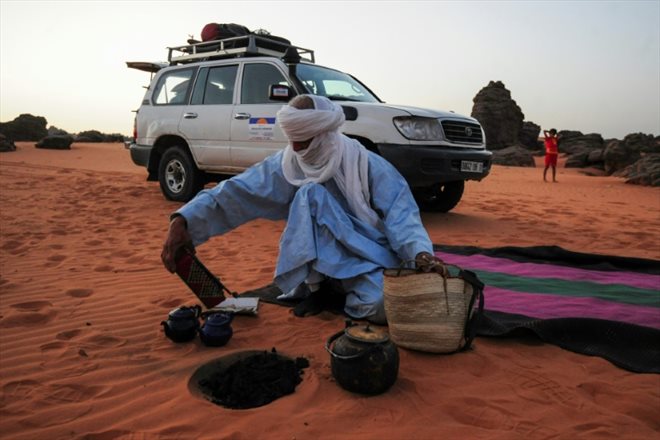The desert near the oasis town of Djanet, 2,300 km southeast of the Algerian capital, on July 28, 2023 (AFP/-)
“Inner peace”, “total rest”: Djanet, oasis of the Algerian Sahara attracts more and more foreign tourists, eager to relax and discover a unique desert landscape in the world.
Since the establishment in 2021 of a system of visas obtained on arrival, more than 4,000 foreigners, according to local media figures, have visited Djanet, 2,300 km southeast of Algiers, and its surroundings, including the Tassili n’Ajjer, a magical site listed by Unesco.
The Tassili n’Ajjer National Park is characterized by a lunar landscape, punctuated by “forests of rocks” of eroded sandstone, geological formations with colors oscillating between orange and black, which delight photographers at sunset. .

Sebeiba Festival in the town of Djanet, 2,300 km southeast of the Algerian capital, on July 29, 2023 (AFP/-)
“We come to Djanet once, we have to go back. That’s exactly what happened for me. There, I’m with two friends, they have only one desire, it’s to come back as soon as possible,” Karim Benacine, a 57-year-old French tourist who works for the music group Universal Music, told AFP.
“I would like to go there often because it recharges my batteries, I’m going to need it. Now that I’ve known that, I think I’m going to do it regularly”, abounds her compatriot, Antonine De Saint Pierre, 49, met by AFP at the end of July.
The Tassili, a vast plateau of more than 70,000 km2, is also home to “one of the most important sets of prehistoric rock art in the world, with more than 15,000 drawings and engravings”, explains Unesco on its site.
These paintings make it possible to follow from 6,000 years BC to the first centuries of the Christian era, “the changes in climate, the migrations of fauna and the evolution of human life on the borders of the Sahara”, underlines the Unesco.

Sebeiba Festival in the town of Djanet, 2,300 km southeast of the Algerian capital, on July 29, 2023 (AFP/-)
In 2021, during the Covid-19 epidemic which weighed heavily on the world tourism industry, the Algerian authorities decided to promote Saharan tourism, by allowing foreigners to have their visa at the airport of arrival in the south of the country, and by opening a direct Paris-Djanet line.
– “Recharge the batteries” –
In 2022, more than 2,900 foreigners of 35 different nationalities, mostly Westerners, stayed in Djanet, compared to 1,200 the first year that Algeria made it easier to obtain visas.

Sebeiba Festival in the town of Djanet, 2,300 km southeast of the Algerian capital, on July 29, 2023 (AFP/-)
To these visitors, last year, we must add 17,000 Algerians who succumbed to the charm of this desert town.
For Samira Ramouni, 41, a psychologist from Algiers, staying in this oasis, “it’s (finding) inner peace, it’s total rest, it’s being disconnected, in search of calm, c also means learning new things, recharging one’s batteries, recharging the batteries to be able to start the obstacle course again”.
Abdelkader Regagda, director of a tourism agency in Tamanrasset, an important locality in southern Algeria located 700 km west of Djanet, is grateful to the authorities for having opened “a great line of tourism from Europe to the south” Algerian.

The desert near the oasis town of Djanet, 2,300 km southeast of the Algerian capital, on July 28, 2023 (AFP/-)
In Djanet, “the circuits are numerous and diverse”, explains to AFP this guide, organizer of excursions around the oasis.
In 1982, Tassili n’Ajjer was recognized as a World Cultural Heritage Site and a World Natural Heritage Site. In 1986, Unesco also added Tassili n’Ajjer to the list of biosphere reserves.
© 2023 AFP
Did you like this article ? Share it with your friends with the buttons below.




